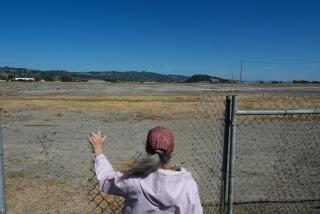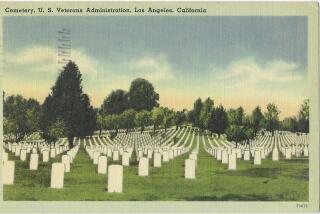Fired Cemetery Chief Accused of Dumping Oil
Borrowing from an old Indian custom he learned in Northern California, George Stelter earlier this year buried a drained oil drum alongside indigent graves in the city-owned Mt. Hope Cemetery.
As the cemetery manager, he used the flattened 55-gallon drum as a brace to stabilize the pauper graves, which he said were shifting and caving in whenever new loose ground was unearthed for more indigent graves at the 120-year-old cemetery.
“The old Indians taught me how to do it,” said Stelter, who owned and operated a Redding, Calif., cemetery for most of his career. “They said they’d done it prior to 1950, using old drums to keep the graves from sliding in.”
His decision cost him his job, and on Friday he was charged with three misdemeanor counts of illegally dumping hazardous waste in the indigent grave areas of the cemetery.
The 67-year-old Stelter was charged with the unlawful disposal of used oil on land, failure to manage used oil as a hazardous waste and mishandling a hazardous-waste container. If convicted, he could be sentenced to a maximum of six months in jail and a $1,000 fine on each count.
Last April, city and state officials disinterred several indigent graves and uncovered the crushed barrel. The flattened drum and soil samples taken from the site were placed in protective custody, and laboratory results showed that levels of refined oil exceeding the government standard had seeped into the ground, officials said.
The district attorney’s office opened its investigation in April, too, but did not file the criminal charges until Friday, the same day a reporter for The Times inquired about the status of its 5-month-old investigation.
Stelter was placed on light duty once the oil drum was recovered, and he was formally discharged from his position June 16.
Termination Notice
According to his termination notice, his order to crush and bury the drum “violated state law in improperly disposing of hazardous waste at Mt. Hope Cemetery.” The notice alleged that he also disobeyed orders not to discuss the matter with other cemetery employees.
The city’s stance is that Stelter had been warned not to bury the drum, that such an action violates state laws, and that he did it anyway, James L. Spotts, the city’s property director, said.
“You cannot handle potential toxic waste materials like that,” Spotts said. “He was warned about it. He did it. And it was not appropriate.
“That’s not good management. That’s not what we want of a manager of Mt. Hope Cemetery.”
Stelter’s attorney, Everett Bobbitt, said Friday that his client is appealing the dismissal to the city’s Civil Service Commission. Bobbitt said that, under a provision of state law, the criminal charges must be dropped if Stelter wins his appeal for reinstatement.
And Stelter insisted that the barrel did not contain any hazardous material.
“This wasn’t hazardous waste,” Stelter said. “These drums only had new oil in them, so how can you consider new oil hazardous? It’s clean, and it came from the earth.”
Stelter, who grew up on a Kansas farm, started his career after World War II, selling burial plots door-to-door in Albuquerque, N.M. He said he later moved to Redding, where he owned and operated the Lawncrest Cemetery from 1950 until moving to San Diego in 1985.
Technique From Indians
It was in Redding, he said, that he hired a Wintun Indian tribal leader and learned about using large metal-sheet scraps as underground braces for coffins buried in loose soil, on top of another or in close-in, tight spaces. He said he used the metal brace process about 40 times in Redding.
After being hired in San Diego, he said, the number of indigent burials in the cemetery’s northern section next to Market Street seemed to be increasing, many of them of unclaimed bodies and homeless people.
“We were having problems,” Stelter said. “The preceding burials were sliding in. The sod would bow in and the earth would slide in, and it would expose the cardboard box of the last burial. You could see some of the remains.
“So we were having this distasteful problem. A number of the people working out there were city employees and not experienced cemeterians, and it began to bother them.”
Steel Drums Accumulated
At the same time, he said, a large number of empty metal drums had accumulated inside the cemetery’s equipment shed, and he was unable to get them removed.
He said he mentioned the metal-brace process to one of the cemetery’s backhoe operators, and that, on Feb. 7, the operator and another employee showed him how they had gone ahead and flattened one of the oil drums with the backhoe.
Meanwhile, a fresh indigent grave was being dug, and two graves alongside it began to open and cave in to the fresh hole. Stelter said he then ordered the employees to bury the flattened drum in there as a brace, and that he supervised their work until it was completed.
“It was fine with them,” he said of the two employees. “In fact, they were grinning and thought they’d done a big deal. They always liked to take new ideas and act on them.
“They were so pleased, and they were elated to put this old drum to use instead of just letting it sit out in the sun all day.”
Stories Differ
The two employees, however, told a different story.
In signed affidavits given to city supervisors, Bob Jones, the backhoe operator, and Steve Daniels said that Stelter ordered the barrel crushed and that, when they flattened the drum, “some fluid came out.”
“Approximately 8 ounces ran into the dirt and was absorbed,” Daniels said. “It was some sort of petroleum product.”
He said the crushed drum was then placed in the backhoe and set into the grave site.
“The grave was open,” Daniels said. “It had been prepared for a double-depth burial. They put the can on one side and then filled the grave.”
Later, another cemetery employee, Wendy Teague, learned of the buried drum and contacted authorities at City Hall. Environmental officials and an investigator from the county district attorney’s office then supervised the disinterment of the barrel, and Stelter subsequently was fired.
But Stelter insisted that the drum contained non-hazardous material. He said it had merely contained new oil that was used for the mechanical equipment on the cemetery grounds. He said none of the oil had ever been contaminated.
Oil Drums Checked
During an inspection by The Times of the cemetery’s equipment shed on Thursday, two employees pointed out another oil barrel similar to the one buried in February. That drum contained new oil for use in the cemetery mechanical equipment, and there were no hazardous-waste warnings posted on the outside of the barrel.
The city disagreed.
“The samples show there was oil in there, and oil is in a class of materials that is against the law to bury,” said Rhea Kulhman, assistant property director.
And she disputed Stelter’s argument that he was simply returning unused oil to the ground. “Oil doesn’t come from the ground in the form it is taken,” she said. “It’s refined, and it’s not the same.”
Stelter said that either way the city never properly trained him on the handling and disposal of hazardous waste. But other employees told city supervisors that Stelter believed the drums held hazardous material, but did not seem to care.
“George was aware that they contained hazardous materials,” Jones said in his affidavit.
In interviews with the district attorney’s office, employees said Stelter was cautioned against having the drums buried in the cemetery, but ignored their warnings. Teague said Stelter “ranted and raved about burying the drums,” even after they discussed government requirements dealing with hazardous material.
Burial Permit Found
The district attorney’s investigation discovered a burial permit signed by Stelter for a 25-year-old indigent who was laid to rest next to the flattened drum. The permit included these handwritten words: “cloth covered wooden--octagon--no liner--steel junk on southside.”
Officials said “steel junk” was an obvious reference to the buried oil drum.
Teague, the cemetery employee who has become acting cemetery manager in the wake of Stelter’s departure, told officials that the “condition of the indigent grave did not warrant any protection such as this drum.”
“We have buried a large amount of indigents here at the cemetery without any liners or protection from the earth caving in,” she said. “This was George’s way of disposing of the drum. The burial was to try and justify it.”
She and other cemetery subordinates who worked for Stelter told investigators that they believed Stelter’s advanced age was causing problems at the cemetery.
“George says things off the wall, and makes dumb remarks,” Larry Guthrie told city officials. “He was sharp when he came to the cemetery, but things have changed recently.”
Added Daniels, another employee: “George was an old-timer, and he lived in the past too much.”
Claims Age Bias
Stelter said he believes the city wanted him removed from the cemetery because of his age, and that they used the buried drum incident as a springboard to run him out. Yet he argued that he has 41 years’ experience in the cemetery business and that his performance evaluation last year was above standard.
More to Read
Sign up for Essential California
The most important California stories and recommendations in your inbox every morning.
You may occasionally receive promotional content from the Los Angeles Times.










